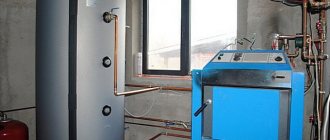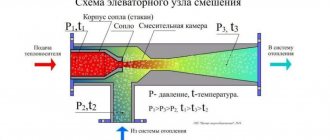As soon as it gets cold outside and the temperature drops to low, it’s time to start the heating season. In order for the population to be warm and comfortable, careful and professional preparation for this season is necessary, which must begin in advance. Preliminary preparation of all thermal facilities according to the drawn up plan so that they can function successfully during the onset of cold weather. The main thing is that the plan of prepared activities meets all established standards, rules and conditions for the implementation of the heating season, as well as the recommendations of the relevant authorities.
What is discussed in the order on preparation for the heating season?
The first step in the process of preparing thermal facilities should be an order that must be issued. The person who will be responsible for the operation of thermal power plants and his deputy are registered here. There are certain requirements for the responsible persons of these organizations, one of the main ones is the presence of a higher heat and power education. And in the future, every year they must pass knowledge tests, which consist of passing an examination.
The order must also include the following fundamental points:
- Formation of commissions in order to prepare the heating system for operation during the autumn-winter period (AWP) and accept this facility, which is on the balance sheet of the enterprise.
- The choice of persons who will become responsible, as well as the numbers of final dates for all parts of the order.
- Drawing up and coordination of an autumn-winter action plan (AWM) in order to prepare the necessary equipment.
- Monitoring and control of preparatory activities, as well as preparation of reports on them.
- The procedure for testing and setting up heating systems.
- Approval of equipment readiness for heating, supported by the procedure for obtaining a special act and passport.
The action plan should be formed taking into account the shortcomings in the functioning of thermal equipment over the past period. Heads of districts and managers of private organizations (for example, HOAs, housing cooperatives) must issue such orders and similar instructions every year before the thirtieth of April. Since it is important that everything is prepared in advance, meetings to approve the heating action plan for 2022 were held in 2022.
Issuance of the act
When repairs, restoration and testing are completed, a special commission checks readiness and issues a certificate according to a fixed template, signed by all authorized persons. Notes with time frames for troubleshooting may be attached.
The document must contain information about:
- complete implementation of the developed and previously approved plan;
- washing, pressure testing of all devices related to heating networks;
- carrying out commissioning tests;
- regime maps of all equipment;
- level of insulation;
- condition of components and parts: locking and adjusting mechanisms, pipes;
- serviceability of metering devices;
- state of protective automation;
- availability of instructions, diagrams and passports of the equipment used;
- sealing on elevator units, limit washers.
If the act is signed, you can use it to obtain a passport giving permission to put the system into operation on time.
When does the heating period begin and end?
The start and end dates of the autumn-winter heating period are established by the relevant regulatory documents of local governments. If the street temperature drops to 8 degrees Celsius and lasts for at least five days, then the heating season should start. Accordingly, when the average temperature rises to 8 degrees Celsius, lasting more than five days, the heating season ends. There is Government Resolution No. 307, the second section of which states that the authorized bodies determine the start and end dates for the contractor’s crime for heating work, if the owners and owners of houses, both individual and multi-apartment ones, have not determined the procedure for setting the start and end OZP, and thermal energy is supplied through central heating networks.
Why is it necessary to prepare for the heating season?
With careful and timely preparation and coordinated operation of housing and communal services facilities, the population can be confident in ensuring a constant energy supply when the temperature drops. For the Russian Federation, established technological heating modes are a priority in the area of growing regional public utilities. By preparing housing and communal services facilities for winter protection, it becomes possible to reduce the influence of temperature or other atmospheric factors on the stability of buildings, prevent their wear and tear, and also protect the operation of necessary equipment from disruptions. The completed preparation of housing and communal services facilities for winter protection can provide the following important aspects:
- rational use of fuel resources and materials;
- high reliability and maximum economy of operation of thermal facilities;
- operation of housing and communal services facilities in accordance with established standards and advanced technologies;
- carrying out an appropriate sanitary and hygienic regime in terms of temperature and humidity in the premises that are acceptable.
Requirements for the preparation of residential buildings
We can highlight a range of fundamental conditions for preparing houses and the engineering systems inside them for the heating season, which are the key to obtaining documents confirming permission to start heating equipment for a specific facility.
The autumn-winter plan includes the following areas:
- Technical inspection of structural elements of houses and structures.
- Repair work to restore heat and power equipment based on the results of the survey in the spring.
- Flushing network pipes with water
- Testing of heating networks using hydraulics.
- Equipping systems with elements and devices that are missing.
- Providing boiler houses with spare energy sources.
- Formation of an act of emergency and technological protection of heat supply.
- Carrying out actions to insulate buildings.
- Issuing and receiving a certificate and passport confirming the readiness of a certain boiler room for the heating season.
The importance of preparatory work
Preparatory activities are carried out annually, and the future heating season 2022-2023 will be no exception. Preparation is extremely important for several reasons. The first is to ensure uninterrupted and constant heat supply to residential buildings at low ambient temperatures. Heat must be supplied consistently.
The second reason is the creation of conditions in residential premises that are optimal for living and comply with generally accepted standards and regulations. In autumn, winter and spring, temperatures must be maintained within a certain range. This is from plus eighteen degrees in all residential premises (in corner rooms - at least 20), not lower than 25 degrees in bathrooms, from 14 to 20 in the staircases of apartment buildings and 16-22 in inter-apartment corridors, and also not less than four degrees in basements and attic areas. Such standards must be complied with.
Helpful information! According to GOST, in premises intended for permanent residence, a temperature range of eighteen to twenty-five degrees Celsius must be observed. And the normal temperature in production and work facilities is from 16 degrees Celsius to 24 degrees.
The third reason is maintaining the operating condition of thermal power systems. Proper preparation ensures minimization of the negative effects of temperature changes and other weather and atmospheric phenomena, maximum stability of objects and complete prevention of malfunctions, emergency conditions and wear.
Preparation for the heating season is a complex and multi-stage process designed to ensure:
- achieving rational consumption of fuel and consumables;
- technological operation of thermal power facilities within the established standards;
- maximum efficiency of network operation;
- reliability of the equipment used;
- implementation of generally accepted legally established sanitary and hygienic regimes in terms of temperature and humidity in residential premises.
If in 2022-2023 the preparatory work is carried out systematically, timely and correctly, then the implementation of the above tasks will become possible.
How to prepare for the heating season
Heads of institutions and organizations of housing and communal construction are fully responsible for the timely and correct implementation of the plan for autumn-winter activities. The work must be carried out in three stages. The first is preparatory, it consists of studying the results over the past heating period. The next stage, the second stage, involves repair work to restore it until the first of September. At the third stage, a check is made to see how ready the equipment is for the beginning of the heating season, after which all systems are tested for operation; if there are any violations, they must be eliminated by the fifteenth of September. And so every time, from year to year, the cycle repeats itself, that is, preparation for the next heating season should begin on April thirtieth, 2022.
At the local government, the headquarters holds meetings where the reports of those responsible for the implementation of the action plan to prepare for the heating season are reviewed. After all the meetings and checks are completed, an assessment of the implementation of the plan is compiled based on their results, and then the information is communicated to the population without fail.
Maintenance of autonomous systems
With the arrival of heat and after the completion of operation of the heating structure, it will be necessary to carry out measures related to the conservation of heat supply equipment for the summer period. The fact is that in this way it is possible to minimize the negative impact of the coolant (water) on the elements of the heating system.
The sequence of actions is as follows:
- a thorough inspection of the elements of the heat supply system is carried out, especially the boiler, radiators, pumps, pipelines, shut-off valves for leaks and other damage;
- identified faults are eliminated, but first the coolant is drained from the network;
- check the functioning of the automatic control systems of an electric or gas heating boiler, as well as the circulation pump and other system components;
- if individual mechanisms and elements are inoperative, they are repaired or replaced;
- When the repair work is completed, the system is filled with coolant.
Thanks to these measures, the house is simultaneously prepared for the heating season. To remove air pockets from the system, there are shut-off valves in certain locations. Carrying out a whole range of work independently allows you to qualitatively prepare for the future period of heat supply at minimal cost, especially since the procedure for preparing for the heating season is standard and is reflected in the corresponding instructions.
How a home property inspection is carried out in the spring
During this inspection, it is necessary to conduct an examination of the technical condition of housing and communal services equipment, the availability of fuel reserves, how reliable is the supply of services to the population, and how the technological modes of functioning of heat transfer were carried out in the past autumn-winter period. During the spring inspection, the following most important areas should be taken into account:
- Inspection of residential buildings, namely engineering structures such as windows, walls, doors, roofing, insulation systems and engineering essences inside the house.
- Generating a report after inspecting the facilities, which will indicate the required types of repair and restoration work, monetary and resource support, persons who are responsible for the execution of the plan, as well as the start and end dates of these works.
- Based on this act, a plan for autumn-winter activities should be drawn up.
- Approval of this plan with local authorities, and then with the head of the organization.
Preparing actions based on inspection results
After the spring inspection, it is necessary to draw up organizational measures, which will take into account the starting and ending numbers, when all the deficiencies found will be specifically eliminated:
- it is mandatory to ensure high-quality drainage of natural waters on the territory of the house, blind areas, and basement;
- all structural elements necessary for work in the basement premises must be checked for serviceability;
- all joints and interfaces must be completely isolated from water, they must be free of any cracks, moisture stains, peeling of the protective layer of concrete structures and other problems;
- during an external inspection, it is necessary to ensure the proper condition of the walls, which should not have any cracks, collapsed plaster or insulation;
- when inspecting windows or doors, you need to take into account the serviceability of the frames, external glazing and the full volume of glazing;
- roofs must be provided with the required temperature and moisture conditions;
- ventilation systems must be checked to ensure they are fully capable of removing waste from gas stoves and water heaters;
- monitoring and complete control of the state of thermal insulation of heating systems inside houses.
Preventative work for heating units during the inter-heating period
Activities to prepare the heating system in individual heating units:
- preparation with checking for serviceability of check valves, as well as safety valves;
- control of the functioning of thermometers, heat regulators, pressure gauges;
- troubleshooting of various threaded connections;
- checking the performance of shut-off valves;
- washing and cleaning of mud traps and filter surfaces.
During the preparation of residential buildings and buildings for the beginning of the heating season, the serviceability of water metering units is also diagnosed. First, a visual inspection of the condition of the water supply system is carried out, then the components are checked for compliance with the requirements and the presence of defects.
Need detailed advice?
Call us: +7(495) 786-95-15
A passport confirming the facility’s readiness for the heating period
There is a standard sample on the basis of which the passport is made. It is issued by a certain authorized body that forms the commission. Such bodies at housing and communal services facilities include territorial authorities. The issuance of a passport can last for 15 days after the act is issued.
Registration and receipt of the relevant document is carried out only when there is confidence that the object is completely ready for the autumn-winter period, after timely elimination of problems in full. Depending on the distinctive aspects of weather conditions, the authorized body sets time limits for the generation of passports confirming the readiness of objects. For heat supply organizations, this date is set no later than the first of November, and for consumers - no later than the fifteenth of September.
Contents of the passport
There are no strict regulations for obtaining a passport. Most often, responsible persons use the sample given in Order of the Ministry of Energy No. 103. The form is advisory and can be adapted to specific conditions. The legislation does not limit the volume and completion of the document. The passport will comply with the recommendations of Order No. 103 if it includes:
- date of registration;
- the name of the department that concluded that the facility is ready for winter;
- Address of the object;
- conclusion based on the results of the inspection;
- signatures of the responsible persons who carried out the inspection, with transcript and seal.
In addition, the document records the technical characteristics of the apartment building: the number of apartments, the percentage of depreciation of the building, the total area, engineering equipment, work performed, the volume of heat resource consumption and other information.
An act of checking readiness for the heating season and an act of the technical condition of the building are attached to the document. Sample acts can also be found in Order No. 103 of the Ministry of Energy of the Russian Federation.
Sample document
Formation of an act based on the autumn inspection
Following the implementation of repair and restoration work and maintenance of heating networks, the established preparation commission is obliged to conduct an autumn inspection of the measures taken, the reliability and readiness of the facilities for the heating period, before the fifteenth of September. After completing this procedure, those responsible for the implementation of the measures must adjust the repair plans, taking into account all detected problems at heat supply facilities. Such deficiencies must be eliminated without fail by September fifteenth. Then you can begin the procedure for drawing up the necessary acts and obtaining a confirming passport.
Connection to existing heating networks occurs before the first of September, and after the fifteenth of September, before the start of the heating season, tests are carried out, which consist of launching heating supply units. According to information from the relevant Ministry of the Russian Federation, after an inspection of about 950 electric power industry entities in 2022, 83 percent received passports confirming their readiness for the heating period. Activities continue at other sites.
Work carried out in preparation for the heating season
All actions to restore heating networks must be linked to a plan for repairing the thermal power forces of heat sources. Persons responsible in accordance with the previously mentioned order must draw up appropriate acts and provide data on the volume of repairs made and the results of inspections carried out.
Checking boiler room equipment
In preparation for the period of heating work, it is necessary to carry out the required measures, which include: repair of boiler heating surfaces, replacement of defective parts of pipes, boiler fittings, air heaters and other installations; repairs to restore fans and pumps; repair and restoration work of chemical water treatment facilities, fuel supply and electrical power equipment; as well as preparing furnaces for heating work and checking heat measuring instruments.
Upon completion of all restoration work, thermal circuits of boiler plants are assembled, where equipment is hydrotested with a pressure of 1.25 of the operating pressure of the steam in the boiler.
Repair work
Based on the results of spring inspections, the following types of repairs should be carried out:
- replacement of pipe parts that are in poor condition;
- repair of various pumps, valves, air vents and flaps;
- restoration of thermal insulation and coating that prevents corrosion;
- repair or replacement of valve control mechanisms and starting devices, as well as instruments that carry out control and measurement work;
- cleaning tanks and mud traps;
- setting up security automation.
After the necessary measures have been taken, the thermal circuit is collected and subsequently tested.
How should devices be checked?
There are certain rules according to which any source and receiver of heat must be equipped with commercial metering devices, and boiler rooms and consumer heating equipment must be equipped with elements of a security system.
In order for all devices to work smoothly and reliably during the autumn-winter period, a thorough check should be carried out, and if necessary, repair of the following devices: adjustment of heat loss and temperature; maintaining pressure in heat supply devices; automatic operation of drainage pumps; as well as devices:
- to protect thermal systems from excess pressure or temperature in the supply network or pressure drop;
- to automatically turn on the spare pump and protect the battery tank from overcrowding;
- by pressure in the network pipeline.
Starting pad and mode cards
Flushing and testing of heating networks with hydraulics is followed by commissioning work on thermal power plants for both companies and consumers. After their implementation, operating schedules for this equipment must be established.
The most important data taken into account in the described cards:
- Estimated volumes of coolant for operational sections of the heating network.
- Operating parameters for pressure in network pipelines: forward and return lines.
- Working temperature graph of network water, taking into account air temperature.
- Waste of thermal fluid from consumers.
- Calculation of heating network temperature expansion.
- Analysis of operating modes of the heating network.
- Calculation of the dimensions of limit washers and nozzles of elevator units for the consumer.
Document on readiness for the heating season
Based on the completion of the necessary repair activities included in the plan, deadlines are set for checking the quality and completeness of the scope of all actions, namely how they correspond to the plan.
To assess how prepared consumers are for the heating period, a special commission checks:
- the completeness of the scope of implementation of all plan activities;
- quality of insulation of objects;
- technical condition of pipes and fittings;
- the presence of washing, pressure testing of devices, regime maps and the availability of commissioning tests;
- operability of devices that take into account electricity;
- functioning of security automation;
- availability of supporting necessary passports.
If complete readiness for the start of heating for the autumn-winter period is revealed, then the preparation of an act that complies with all the rules, signed by members of the special commission, begins. This document may be supported by any important notes on troubleshooting, by eliminating which the passport can soon be received by consumers.
Pressure gauges
Perhaps the first thing an inspector turns his attention to when accepting pressure testing is the pressure gauges.
Checking the pressure gauge
Pressure gauges must be verified every year. Verification is a test of a measuring device for accuracy of readings. If the pressure gauge readings exceed the permissible error, it must be sent for calibration or replaced. Calibration, in essence, is the adjustment of a pressure gauge aimed at reducing the error in measurement accuracy.
After verification, a stamp of the Metrological Service is applied to the pressure gauge body.
1. Month of the year (1, 2, 3, etc.), quarter (I, II, III, IV). 2. Gosstandart sign. 3. Last numbers of the year (here 2002). 4. Individual sign of the verifier. 5. Code of the Metrological Service.
New pressure gauges are subject to verification only after 18 months, that is, a year after commissioning. But when checking, you must provide passports for these devices (they are included in the kit).
Pressure gauge connection
The pressure gauge must only be connected through a three-way valve or a ball valve with a pressure release valve. Conventional ball valves do not work.
Three-way valves often leak. Tip: to avoid leaks, rotate the valve stem several times around its axis before installation. This way you will evenly lubricate the stem and the inner surface of the tap with the grease that was applied during assembly.
Where should pressure gauges be located?
Regarding the installation location of pressure gauges, there is a whole bunch of standards (DBN V.2.5-39 - Heating networks, SNiP 2.04.01 - Internal water supply and sewerage of buildings, SNiP 2.04.05 Heating, ventilation and air conditioning, SNiP II-35 Boiler installations). In simple words, I will say this: pressure gauges should be placed before and after any equipment that can affect pressure changes: on all outgoing and passing pipelines, before and after shut-off valves, before and after control equipment, before and after mud traps (to monitor its condition) and etc.
Another nuance that an inspector can pay attention to is the rating of the pressure gauge. Heating points should have pressure gauges with a rating of up to 1.6 MPa (16 bar).











